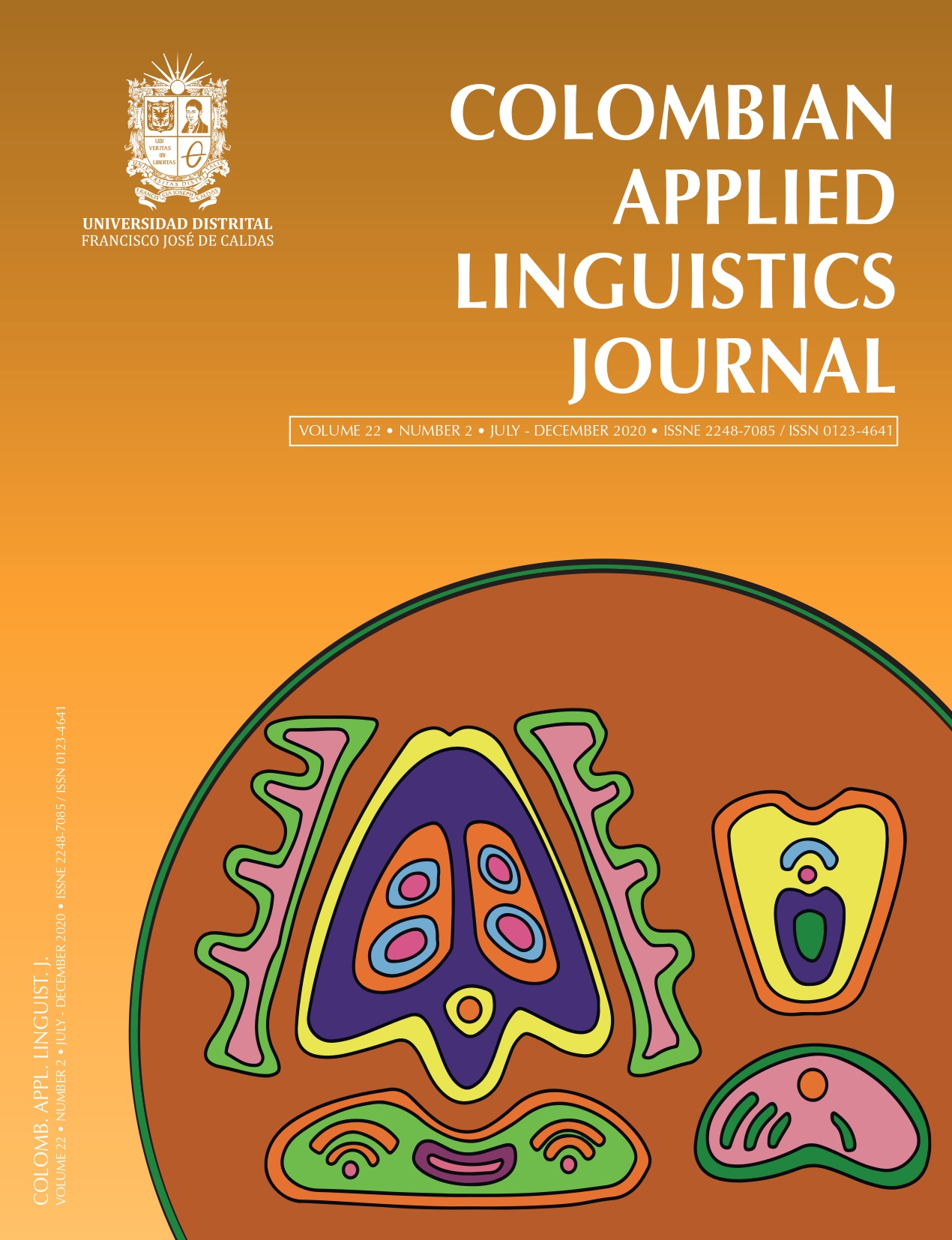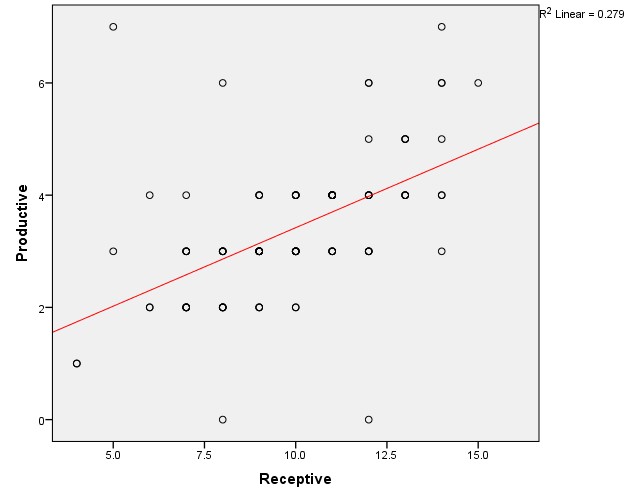DOI:
https://doi.org/10.14483/22487085.16023Publicado:
2020-12-22Número:
Vol. 22 Núm. 2 (2020): Julio-diciembreSección:
Debates de enseñanzaA Study On the Use of Collocations in Business Class Learners
Un estudio sobre el uso de combinaciones de palabras en estudiantes de administración
Palabras clave:
business, collocations, ESL learners, lexicography, second language acquisition (en).Palabras clave:
administración, combinaciones de palabras, estudiantes de inglés como segunda lengua, lexicografía, adquisición de segunda lengua (es).Descargas
Referencias
Alsulayyi, M. N. (2015). The use of grammatical collocations by advanced Saudi EFL learners in the UK and KSA. International Journal of English Linguistics, 5(1), 32.
Anwar, R. M. B., & Khan, L. A. (2012). Collocations and second language use: Errors made by advanced learners in Pakistan. Arts, Social Sciences, 47.
Boonyasaquan, S. (2009). An analysis of collocational violations in translation. วารสาร มนุษยศาสตร์ ปริทรรศน์ (MANUTSAT PARITAT: Journal of Humanities), 27(2), 79–91.
Brashi, A. (2005). Collocability as a problem in L2 production. Reflections on English Language Teaching, 8(1), 21–34.
El-Dakhs, D. A. S. (2015). Collocational competence in English language teaching: An overview. Arab World English Journal (AWEJ) Vol, 6(1), 68–82.
Firth, J. R. (1957). Papers in linguistics: 1934–1951. London: Oxford University Press.
Gheisari, N., & Yousofi, N. (2016). Iranian pre-university student’s retention of collocations: Implicit exposure or explicit instruction. Cogent Education, 3(1), 1184826, 1–12.
Halliday, M. A. (1966). Lexis as a linguistic level. In Memory of JR Firth, 148, 162.
Higuchi, M. (1999). Collocational problems in EFL learning. 研究紀要, (13), 45–56.
Harida, E. S. (2019). Collocations mastery of the university students. Elite Journal, 1(2), 201–208.
Khan, J., & Liu, C. (2020). The impact of colors on human memory in learning English collocations: Evidence from south Asian tertiary ESL students. Asian-Pacific Journal of Second and Foreign Language Education, 5(1), 1–10.
Khittikote, R. (2011). The ability to use collocations for business purposes by Thai EFL learners. Language Institute, Thammasat University.
Koosha, M., & Jafarpour, A. A. (2006). Data-driven learning and teaching collocation of prepositions: The case of Iranian EFL adult learners. Asian EFL Journal, 8(4), 192–209.
Lewis, M., Gough, C., Martínez, R., Powell, M., Marks, J., Woolard, G. C., & Ribisch, K. H. (1997). Implementing the lexical approach: Putting theory into practice (Vol. 3, No. 1, pp. 223–232). Hove: Language Teaching Publications.
Martyńska, M. (2004). Do English language learners know collocations? Investigationes linguisticae, 11, 1–12.
Mahmoud, A. (2005). Collocation errors made by Arab learners of English. Asian EFL Journal, 5(2), 117–126.
Matsuno, K. (2017). Processing collocations: Do native speakers and second language learners simultaneously access prefabricated patterns and each single word? Journal of the European Second Language Association, 1(1).
Nesselhauf, N. (2003). The use of collocations by advanced learners of English and some implications for teaching. Applied Linguistics, 24(2), 223–242.
McCarthy, M., & O'Dell, F. (2008). English vocabulary in use: Vocabulary reference and practice with answers. Advanced. Cambridge University Press.
Michael, M., & Felicity, O. D. (2005). English collocations in use intermediate.
O’Dell, F., & McCarthy, M. (2008). Collocation in use: Advanced.
Palmer, F. (1979). Semantics. Cambridge: Cambridge University Press.
Palmer, F. R. (1995). Firth and the London School of linguistics. In Concise history of the language sciences (pp. 268–272). Pergamon.
Shehata, A. K. (2008). L1 influence on the reception and production of collocations by advanced ESL/EFL Arabic learners of English (Doctoral dissertation, Ohio University).
ShuCai, G. (2017). A corpus-based study of verb-noun collocations in the argumentative essays of University EFL Learners in China (Doctoral dissertation, Universiti Sains Malaysia).
Sinclair, J. M. (1966). Beginning the study of lexis. Memory of JR Firth.
Williams, G., & Millon, C. (2011, July). Palmer, Firth and Internet: Drawing together collocational threads.
Zaabalawi, R. S., & Gould, A. M. (2017). English collocations: A novel approach to teaching the language's last bastion. Ampersand, 4, 21–29.
Cómo citar
APA
ACM
ACS
ABNT
Chicago
Harvard
IEEE
MLA
Turabian
Vancouver
Descargar cita
Recibido: 12 de marzo de 2020; Aceptado: 22 de septiembre de 2020
Resumen
Previos estudios han informado de la falta de competencia en la ubicación y las dificultades entre los estudiantes de inglés como segunda lengua (ESL). Sin embargo, las combinaciones de palabras son cruciales en la adquisición de un segundo idioma. Esta investigación examinó el conocimiento receptivo y productivo de las combinaciones de palabras entre los estudiantes de administración de la Universidad COMSATS de Islamabad (Campus de Vehari) que estudiaron ESL. También investigó la brecha en el uso de estas combinaciones a nivel receptivo y productivo. La muestra incluyó 61 hombres y 39 mujeres, de un total de 100. Empleando un enfoque cuantitativo, recopilamos los datos mediante un cuestionario y dos pruebas de colocaciones, y los analizamos por medio del programa SPSS versión 20. El resultado general de la prueba de colocación indicó que el 66,4 % de los encuestados tenía la respuesta correcta a nivel receptivo y solo el 33,7 % a nivel productivo. Además, el resultado estadístico presentó una gran brecha en la capacidad de utilizar combinaciones de palabras en los niveles productivo y receptivo. Este resultado también afirmó que, a pesar de su capacidad para comprender las combinaciones de palabras, los estudiantes tenían dificultades para identificar con seguridad las combinaciones de palabras adecuadas en inglés. Las experiencias en el idioma local y nativo podrían ser una de las razones que hicieron que los estudiantes no tuvieran más confianza en identificar las combinaciones de palabras en inglés.
Palabras clave
administración, combinaciones de palabras, estudiantes de inglés como segunda lengua, lexicografía, adquisición de segunda lengua.Abstract
Previous studies have reported lack of collocational competence and difficulties among English as a second language (ESL) learners. However, collocation is crucial in second language acquisition. This research examined the receptive and productive knowledge of collocations among the business students of COMSATS University Islamabad Vehari Campus who studied ESL. It also investigated the gap in the use of collocations at a receptive and productive level. The sample included 61 males and 39 females out of the total sample size of 100. Employing a quantitative approach, we gathered the data through a questionnaire and two collocations tests, and we analysed them via SPSS version 20. The overall result of the collocation test indicated that 66.4% of the respondents had the correct answer at the receptive level compared with only 33.7% at the productive level. Moreover, the statistical result presented a great gap in the ability to utilise collocations at the productive and receptive levels. This result also affirmed that despite their ability to understand the collocations, the students had difficulties in identifying proper English collocations confidently. Local and native language experiences might be one of the reasons that caught the students from being more confident in identifying the English collocations.
Keywords
business, collocations, ESL learners, lexicography, second language acquisition.Introduction
Considerable attention has been given to the importance of teaching and learning collocations among English as a second language/English as a foreign language (ESL/EFL) learners over the last two decades. Unlike grammar, collocations are arbitrary and lack predictability and common rules. It also does not depend on guessing but on rigorous language drills and on making mistakes and learning through the corpus, dictionaries and vocabularies (Koosha & Jafarpour, 2006). This is the primary reason why learning collocation is highly important for ESL/EFL learners. Secondly, the mastery of collocations determines whether ESL/EFL learners had reached their level of mastery, intermediate or advanced. Certainly, it is inappropriate for ESL/EFL learners to graduate in their field of studies but not make progress in mastering English collocations. The mastery of English collocations stays useful for their future career and promotion (Harida, 2019). Thirdly, knowledge and skills on collocations also benefit the mastery of L1. A better understanding of collocation in L2 would certainly increase the ability to express ideas in L1. Fourthly, a better mastery of collocation in L2 among ESL/EFL learners will be beneficial in terms of using English at the productive and receptive levels. Finally, collocations enormously contribute to efficient language comprehension and production (El-Dakhs, 2015).
Origin of the Term ‘Collocation’
A collocation comprises a sequence of words that occur together in a prescribed order. It also does not have a relationship necessarily with grammar, and knowledge of rules does not help them to formulate. Hence, collocations are not easily mastered and typically only dealt with during the latter phase of second language education (Zaabalawi, 2017). Historically, Firth (1957) is widely regarded as the developer of a lexical and the father of collocation since end of the 1950s (Martyńska, 2004; Shehata, 2008). Notwithstanding, it was Palmer (1979) who first introduced the notion of ‘collocation’ in the 1930s. Linguists and researchers, however, agree that Palmer and Firth had a great contribution towards the development of the study of collocation. Palmer introduced the term ‘collocation’, and Firth was the first to use it as a technical term (Williams & Millon, 2011; El-Dakhs, 2015).
Definition
Although collocation has already been established as a study discipline in ESL/EFL and L2, linguists have defined it in various ways. Firth (1957) defined collocation as ‘the company that words keep’. Since then, the definition was expanded and extended by linguists and researchers for explaining the nature of collocation and facilitating their research. Firth also perceived the concepts of the lexical relations of collocation as syntagmatic rather than paradigmatic. Both of his followers Sinclair (1996) and Halliday (1966, pp. 148–162) further developed the concepts. Halliday (1966, pp. 148–162) perceive collocations as the examples of word combinations and maintained that collocation cuts across grammar boundaries. Sinclair (1966) developed an approach to understand the concept of collocation that integrates the lexical and grammatical aspects of collocation. The approach is well known among Neo Firthians, where the context of corpus linguistics is very different in that it places collocation at the heart of language as an essentially dynamic process, in which meanings are created and exploited within textual contexts (Williams & Millon, 2011; Martyńska, 2004). Other linguists have also attempted to propose a better and well-phrased definition, such as Lewis (1997, pp. 223–232) who viewed that collocations are those combinations of words that occur naturally with a greater than random frequency. In addition, Brashi (2005, pp. 21–34) defined collocation as ‘the tendency for certain words in a language to combine with one another (as against others that do not have this tendency of combining together), and the meaning of which can be deduced from at least one of the components of the collocation’.
Concept
In line with the above definitions, El-Dakhs (2015) explained that arbitrariness is an essential characteristic of collocations. Given that word combinations are referred to as collocations consistently occurring together, any word combination showing an infrequent co-occurrence is not classified as a collocation. For instance, yellow hair is not a collocation, but blonde hair is. In everyday English, yellow does not collocate with hair, but it does collocate with flowers or paint. The choice of the constituent words does not follow any logic but is only based on a linguistic convention. There is no apparent reason and logical explanation of why we say making friends rather than getting friends or heavy rain rather than strong rain (O’Dell & McCarthy, 2008). In fact, this arbitrariness is the only explanation why ‘we say to break rules but not to break regulations, to hold a funeral but not to hold a burial, to make an attempt but not to have an attempt and to have a try but not to make a try’ (Sinclair, 1991; El-Dakhs, 2015).
Studies on Collocations
Studies have elucidated that mastering collocation is one of the major problems among ESL learners (Higuchi 1999); Nesselhauf, 2003; Martyńska, 2004; Brashi, 2005; Hong, 2014; Fatima, 2015; Gheisari & Yousofi, 2016; Matsuno, 2017). ESL learners lack the collocation capability to express their thoughts and ideas in writing and speaking English (Hill, 2000). Researchers have also studied the deficiencies in using collocations among ESL learners. Abbas Brashi (2005) conducted a study on collocability problems among undergraduate students majoring in English at Umm Al-Qura University, Saudi Arabia. The respondents were twenty senior students in their fourth year (final year) of study. The study intended to identify the difference between the EFL learners’ productive and receptive knowledge of English verb + noun collocations. The findings validated that the respondents essentially lacked collocational competence at the production level. Sixty-two per cent of their responses at the productive level were incorrect, whilst only 38% were correct. They performed better at the receptive rather than at the productive level. Approximately 79% of the responses of the participants at the receptive level were correct, whilst only 21% were incorrect (Brashi, 2005). A study by Khittikote (2011) among Thailand’s EFL learners of Thammasat University at the advanced level found that only 18% of the respondents received good scores (between 11 and 15 points) at the receptive level and that 60% earned moderate scores (8–10 points). The overall mean score was 9.02 points. Ninety-eight per cent of the respondents answered correctly for the verb–noun collocation of ‘Visit a website’, whilst 90% of them answered incorrectly for the verb–noun collocation of ‘Send an attachment’. Findings revealed that the respondents encountered difficulties in recognising collocations at the receptive level although they were studying English at the advanced level and had exposure to English and collocations on a regular basis from their workplace and daily life.
Some studies have explored the details of collocations either from grammatical or lexical collocations or both. Benson et al. (1997) divided collocations into two major groups, namely, lexical and grammatical collocations. Among the patterns of lexical collocations are the following: verb + noun phrase (or prepositional phrase) (e.g. compose music), verb + noun (reject an appeal), adjective + noun (strong tea), noun + verb (bombs explode), noun1 + of + noun2 (a pride of lions), adverb + adjective (deeply absorbed) and verb + adverb (argue heatedly), whereas the patterns of grammatical collocations are as follows: noun + preposition (e.g. blockage against), noun + to + infinitive (an attempt to do it), noun + that + cause (He took an oath that he would do this duty), preposition + noun (on the advice of somebody), adjective + preposition (They are angry at him), adjective + to + infinitive (He is ready to go), adjective + that + cause (She was afraid that she would fail the exam) and verb + direct object + to + indirect object (He sent the book to her) (Benson, Benson et al. 1997).
Significance of the Study
Collocations are related to four types of language learning skills, namely, reading, listening, speaking and writing. Reading and listening are collocability skills at the receptive level, whereas speaking and writing are collocability skills at the productive level (Brown 2000); Higuchi, 1999; Brashi, 2005). For many years, researchers have been focusing on studying the receptive and productive levels. Some intended to identify the level of mastery for each level to propose appropriate teaching and learning approaches to improve the skills. Some experimented with certain teaching approaches that could be useful to improve the skills of ESL/EFL learners. Although the mastery of collocation skills at the receptive and productive levels is considered essentially important, studies have confirmed that most ESL/EFL learners at the advanced level in Asian countries were lacking behind the satisfactory level (Mahmoud, 2005).
Collocations are quite new to ESL learners and teachers in Pakistan and are excluded from the standard curricula of English language teaching. Most classrooms are set around grammar and vocabulary emphasising the meanings of single words (Anwar & Khan 2012). ESL learners study English as a compulsory second language in their early education period in Pakistan. Despite studying English for a long time, students do not manage to master the language and produce the language fluently in a natural way. Many students face problems in employing appropriate verbs with appropriate nouns and prepositions with verbs (Khan & Liu, 2020; Anwar & Khan 2012). These problems cause misinterpretations in understanding the meaning of messages by native speakers. This is a major problem not only with Pakistani ESL learners but also with many other ESL learners in Asian countries, such as China, Bangladesh, Thailand, Saudi Arabia, Japan and the rest of the continent. The lack of knowledge of collocations is one of the reasons that causes this problem (Boonyasaquan, 2009).
Teaching collocation is also quite new to ESL teachers and educators in Pakistan. The teaching of collocation has been included in classroom activities in a very limited way in other Asian countries too (Khittikote, 2011; Hong, 2014; Boonyasaquan, 2009; Shucai, 2017). Due to the lack of emphasis on collocation in teaching and learning, Pakistani ESL learners face problems in using English properly (El-Dakhs 2015). Possibly, the majority of Pakistani ESL learners may not know the importance of collocations in improving their English mastery, and this situation could consequently be an obstacle to effective communication among ESL learners. The lack of ability in using proper collocation would reduce the opportunity to expand and connect with the global business community in the business and commercial fields. It has been uncertain whether Pakistani students in business degrees (Bachelor and Master of Business Administrations (BBA and MBA, respectively)) achieve a certain level of mastery in collocations. Do they really know the term ‘collocation’ and its importance in achieving English competency close to a native speaker? Another notable aspect is whether the students adequately study collocations and are able to practice proper collocations in their daily life and in their workplace.
Phrases and collocations are difficult for the first and second language users of the English language (Nesselhauf, 2003). Many ESL learners produce incomplete collocations. For instance, many users say ‘open the light’ rather than ‘turn on the light’ due to the influence of their native language. Most importantly, in many non-English-speaking countries, native speakers are unavailable as English language teachers. Consequently, English teachers do not have sufficient ability in collocation, and teaching collocations effectively remains a problem for English teachers. In light of the abovementioned problems, the ability to produce collocations at the productive and receptive levels is, therefore, determined by the current study. This study would help in encouraging the prominence of learning collocations among the learners.
Due to meagre and limited research on collocations in Pakistan, this study would prove a base and milestone for other students to conduct further research. Findings from this study may also help develop an awareness among Pakistani ESL learners to focus more on collocations. This study intends to investigate the collocation competence level of Pakistani ESL learners in business studies. Specifically, this study is a case study on business students at COMSATS University Islamabad Vehari Campus (CUI Vehari), Pakistan. The two key objectives of the study are to identify the competency of the respondents in using collocations for business purposes and to investigate the gap between their knowledge of collocation at the productive and receptive levels.
Method
This quantitative study in second language acquisition objected to identify the competency level of EFL business learners at CUI Vehari, Pakistan in using business collocations and the breach between their knowledge of collocation at the productive and receptive levels. Moreover, the study investigated the respondents who differed on one key characteristic at one specific time period. The data were collected from BBA and MBA EFL learners at CUI Vehari.
Instruments and Data Collection
The instruments were applied to collect the data from the respondents. The first is the set of questionnaires distributed in two parts. The first part comprises seven questions to collect information about personal data and demographic information about the respondents, e.g. name, sex, age, current occupation, education and the time period of studying English. The second part is composed of three questions with respect to the frequency of exposure to English in three divergent activities. The second part aims to evaluate the frequency of English language exposure on a weekly basis by using the 4-points Likert scale. These three questions were used to evaluate the exposure to English in four skills, i.e. listening, speaking, reading and writing skills.
The second instrument is a set of collocations comprising two tests to measure the level of knowledge among the respondents in using collocations for businesses. The first collocation test is for the receptive level that is composed of 15 multiple-choice questions of verb–noun business collocations. Each question had two distractors and one right answer. The respondents are supposed to select the verb as per the appropriate noun. The second collocation test is for the productive level test. In this productive collocation test, the respondents must fill in the blanks to complete the sentence. In each question, the respondents must write down the appropriate verb or noun to collocate with the given noun that is in bold. This test comprises 10 questions, and it aims is to evaluate the collocation knowledge at the productive level.
The selection of words for business collocations in the tests as discussed above is drawn from the following sources:
-
Michael McCarthy and Felicity O’Dell, English collocation in use: Intermediate, Cambridge University Press (2005).
-
Michael McCarthy and Felicity O’Dell, English vocabulary in use: Advanced, Cambridge University Press (2017).
As the part of the collocation tests, the 25 business collocations were selected following certain steps. Firstly, the business collocations including verb–noun were gathered in each textbook and website relating to the selected topics, including marketing and selling, business negotiations, meetings and business correspondence. Secondly, 80 verb–noun collocations were retrieved from three sources to recognise the repeatedly used verb– noun business collocations. Thirdly, the business collocations that occurred with a minimum of two out of three sources were carefully chosen to be included in the tests.
Data Analysis and Findings
Table 1: Gender

The respondents were composed of 61 males and 39 females out of the total sample size of 100. This is following the demographic nature of the students’ intake, particularly in BBA and MBA programmes at CUI Vehari.
Table 2: Age Group

Table 2 demonstrates the descriptive statistics of the demographic variable of the respondents’ age, which reveals that 34% are in the group age of 15–20 years, 47% in the group age of 21–25 and only 19% in the group age of 26–30 years. These figures reflect that the majority of the respondents are in the group age of 21–25 years.
The demographic variable of the study programme is described in Table 3, which illustrates that the majority of the respondents (66%) are from the BBA programme and that 34% are from the MBA programme. These student groups at the tertiary level are considered more mature and are expected to have gone through many years of English language learning experience. They should have reached a certain level of collocation mastery.
Table 3: Programme of Study

Table 4: Recognition of Collocation

Table 4 shows the data collected from the question about the recognition of collocation among the respondents. The data show that a great majority of the respondents (93%) admit that they recognise the collocation. This evidently shows that the respondents have a better awareness of the term ‘collocation’. In the first collocation test, which is the test for the receptive level, the respondents were asked to answer 15 multiple-choice questions of verb–noun business collocations. Table 5 below shows the test results.
Table 5 shows the collocation test results at the receptive level. The results show the rank of each verb–noun business collocation according to the level of the respondents’ percentage score. In addition, the results exhibit that the item ‘Visit a website’ gained the highest score of 82% and that it ranked first. Four items had equal scores. Items 6 and 8 both recorded 73% and ranked fifth, whilst items 9 and 15 both scored 67% and ranked seventh. The lowest score was recorded for item 7 ‘Send an attachment’ which recorded 47% and ranked thirteenth. The overall percentage score for the collocation test at the receptive level indicated that 66.4% of the respondents successfully answered the test correctly. This represents two-thirds or a bigger majority of the respondents with a good collocation mastery at the receptive level.
The second collocation test was for the productive level test. In this productive collocation test, the respondents needed to fill in the blank to complete the sentence. In each question, the respondents had to write down the appropriate verb or noun to collocate with the provided noun in bold. This test consists of 10 questions, and it aims to evaluate the collocation knowledge at the productive level. Table 6 shows the test results.
Table 6 shows the collocation test results at the productive level and the frequency of the correct and incorrect answers. The results present the rank of each verb–noun business collocation according to the level of the respondents’ percentage score. The results further manifest that item 3 ‘Make a report’ gained the highest score of 43% and that it ranked first. Four items had equal scores. Items 6 and 7 both recorded 38% and ranked fourth, whilst items 4 and 5 both scored 26% and ranked seventh. The lowest score was recorded for item 2 ‘Share an opinion’ which recorded only 20% and ranked eighth. The overall percentage score for the collocation test at the productive level indicated that only 33.7% of the respondents successfully answered the test correctly. This represents only one-third or a small number of the respondents with a good collocation mastery at the productive level.
Table 5: Receptive Collocation Test Result
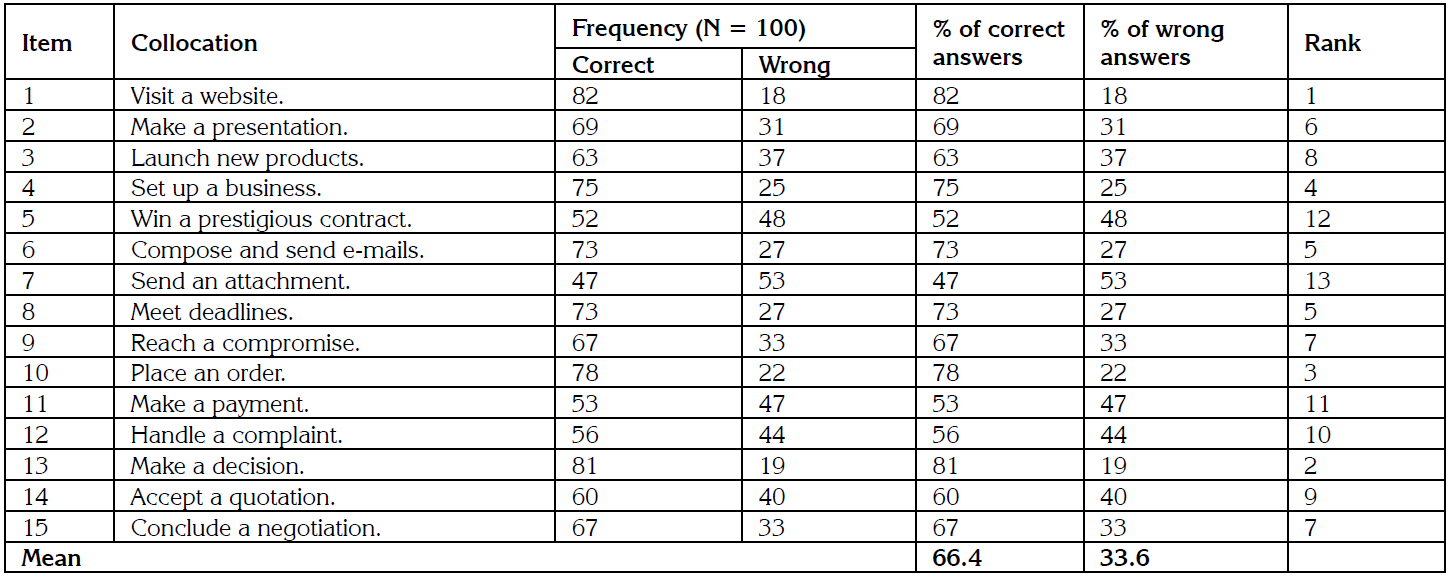
Table 6: Productive Collocation Test Result

Regression Model
Regression analysis is a reliable method that assesses the reliance of a variable upon another variable and was employed to indicate the relationship between the anticipated values of variables. Regressions which have an explanatory variable are called simple linear regression analysis, albeit if it contains two or more than two explanatory (independent) variables than it is known as multiple linear regressions. Thus, in the present study, the writer adopted a simple linear regression model to analyse the data, and the linear equation of this model is described below that helps calculate the value of constant coefficient B0 and the slope coefficient . as follows,
Y = B0 + BX + ε
Where
Y = is a dependent variable (productive collocation), B = constant; the value of Y when X = 0
B = beta coefficient,
X = is an independent variable (receptive collocation), and ε = the ‘estimated error’ of the regression model.
Furthermore, the results of this statistical model are given below in detail.
Table 7: Model Summary
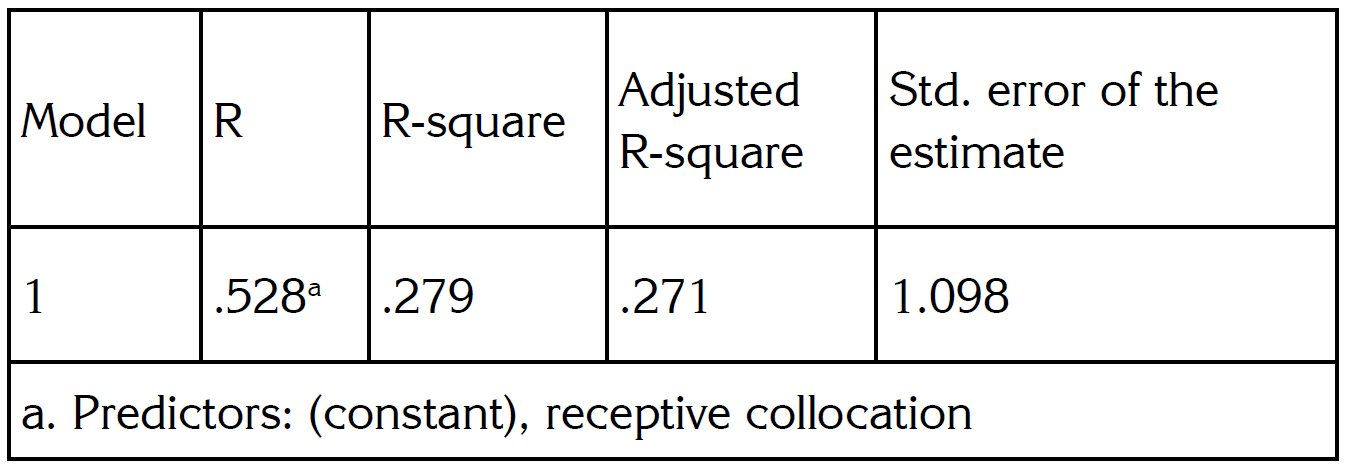
Table 7 illustrates the model summary of this analysis. The ‘.’ (correlation of coefficient) value is 0.528 which reveals that there is 52.8% positive moderate level of the association are in the variables that are found in this model. The second column contains the value of ‘R²’ (coefficient of determination) which explains how much of the total proportion of variation is brought by the outcome variable in the predictor variable. The ‘R-square’ value is 0.279, which means that 27.9% of our dependent variable explains the variability of the predictor variable, whilst the rest of 72.1% of variation (change) in the predictor variable is shown by other extraneous variables that have not been discussed in the present study. Thus, this implies that the overall statistical model is significant and adequate for the data.
Table 8: ANOVAa
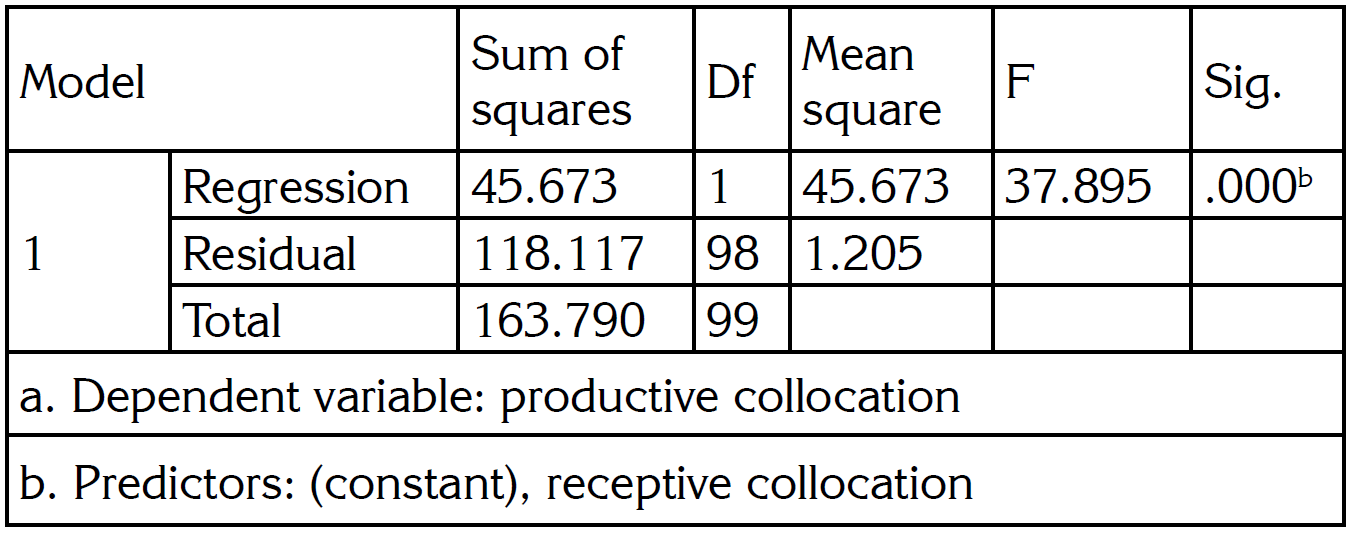
The results of ANOVA test are described in Table 8 that helps in knowing about the statistical significance and fitness of the regression model. The researcher must pay attention and should be sure about the fitness of the model for the estimation of the results. If the model fitness is appreciable, then it produces reliable results; otherwise, it should be changed. In this case, the F-statistics value plays a pivotal role in the table. If this statistical value is greater than 4%, then it means that the model shows durable results and is fairly statistically fit for the study. Therefore, in the present research, the F-statistics calculated value is 37.89, which is higher than a critical value of F = 4. Furthermore, the p-value is 0.000, which is less than 0.05 and shows statistically significant results. Hence, the findings verify that our regression model is suitable and best fits the analysis.
Table 9: Regression coefficients
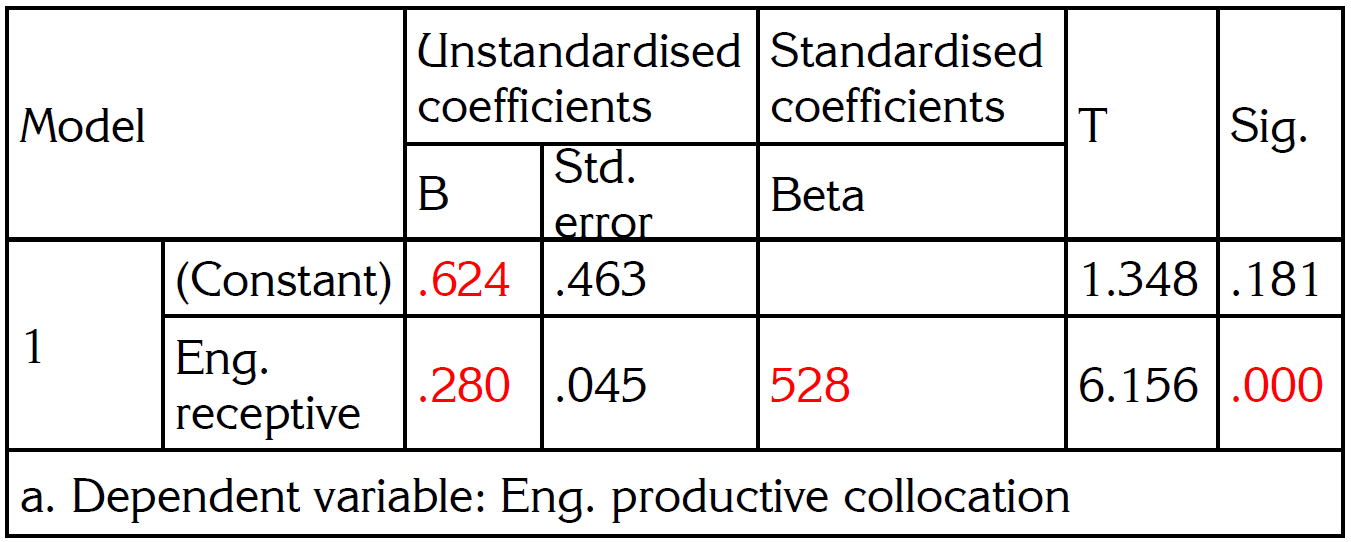
Table 9 yields the coefficients of the regression model, where the collocation test at the receptive level is considered an independent variable, whilst the collocation test at the productive level is taken as a dependent variable. The results of the regression coefficients model are described as in the equation below:
Y = B0 + BX + ε
Y= 0.624 + 0.280X + ε
It indicates that if the predictor variable value goes up by one unit than in response it will lead to an increase the value 0.280 in outcome variable. The coefficient of the independent variable is perceived to be 0.280, and the p-value is 0.000 less than 0.05, which means that the predictor variable is positive and statistically significant. Eventually, the test result clearly affirms that the scores of the collocation test at the receptive level are always greater than the scores of the collocation test at the productive level.
In Figure 1.1, the scatter diagram demonstrates the visual display of the Pearson correlation test and also indicates that there is some faint evidence that reflects the positive association. As shown in Table 7, ‘.’ and ‘R²’ values are 0.528 and 0.279, respectively, showing a positive appreciable moderate level of association between the outcome and predictor variables. This clearly indicates that if the value of the right answers increased at the receptive level than definitely, then the value of the right answers also improves at the productive level. Furthermore, the association between the productive collocation (dependent variable) and the receptive collocation (predictor variable) is a fairly linear one. Hence, both these variables are interrelated, and the linear line is positive and inclines upwards to the right.
Discussion
This research examined the receptive and productive knowledge of collocation among business students studying ESL. It also investigated the gap in the use of collocation at the receptive and productive levels. In light of the data analysed, it is affirmed that the vast majority of the learners had better awareness to recognise the collocation at the receptive level (mean = 9.96) than the productive level (mean = 3.37). Furthermore, the results of this study clearly confirmed that the students did not have the great ability to perform well on the production test of collocations. In addition, the depleted scores of the productive test illustrate that the learners did not have sufficient knowledge to produce collocations. For instance, a great majority of the participants, i.e. 70%, provided incorrect answers to the noun–verb collocations, namely, ‘Share an opinion’, ‘Allocate a budget’, ‘Design a campaign’ and ‘Manage risks’ at the productive level (Table 6). Moreover, the regression test was utilised to find the difference and correlation between the collocation tests of the productive and receptive levels which showed the positive correlation and proved that the respondents had great awareness about collocation. Hence, they obtained three times higher scores at the receptive collocation test instead of the productive level of the collocation test (Table 9). The obtained findings of the present study also corroborate earlier findings of linguistics and researchers like Brashi (2005, pp. 21–34) which confirmed that EFL or ESL learners had better ability to perform the collocation test at the receptive level instead of the productive level. Furthermore, the findings of the current study also supported the study of Kozlowski and Seymour (2003), which indicated that EFL learners often produced awkward or unnatural collocational terms in their language. Further, some of the studies compared the errors in collocations based on English language proficiency. In this regard, Alsulayyi (2015) investigated the production of English grammatical collocations among Saudi students majoring in English in the Kingdom of Saudi Arabia and those studying in the United Kingdom. Two groups, consisting of a total of 10 Saudi undergraduate students, at stage two, participated in the study. Five of them were from the school of English at Manchester Metropolitan University in the United Kingdom, whilst the other five were from Najran University in the Kingdom of Saudi Arabia. The researcher analysed the essays written by the participants. The results reveal that Saudi EFL learners in the United Kingdom do grammatical collocation errors less than those who learn English in the Kingdom of Saudi Arabia. Additionally, the highest number of errors in both groups was recorded on the grammatical collocation patterns, noun + preposition and adjective + preposition. The researcher contended that the L1 interference plays a crucial role in the erroneous responses of the students, especially those which contain a preposition. This was proven as the majority of noun + preposition, adjective + preposition and preposition + noun is used incorrectly throughout the essays.
Figura 1: 1 Scatter Plot of Pearson Correlation Coefficient Test
The findings of the current study entail several pedagogical implications for ESL learners of business studies. Firstly, identifying techniques for the acquisition of collocation is chiefly important. There should be various strategies and techniques for teaching collocations in business to enable the learners to identify and use collocations effectively and appropriately. Secondly, research articles aiming to improve the mastery of collocations has a special significance to be kept in mind whilst teaching. Thirdly, ability in the English language should be improved to have a command on the proficiency in collocation. Finally, keeping in view the negligence towards the concept in Pakistan, there should be a separate subject for gaining efficiency in the subject on the part of teachers and learners.
Conclusion
Learning a second language could be a daunting job for students at lower levels. This is certainly expected because students at primary and lower secondary schools are largely exposed to a spoonfed learning and teaching approach. Moving up to a higher level, they should be able to overcome the problem of learning the second language through more exposure and experiential learning. However, this is not always the case when there are more pulling than pushing factors. Learning and mastery English collocations are especially challenging for students in non-English-speaking countries due to the lack of English native-speaking experience. Conversely, local and native language experience will certainly be the major pulling factor that continuously influences the ability of the students to master English collocation. In the worst-case scenario, this could develop another form of an English-speaking format that represents local expressions, such as ‘Singlish’ in Singapore. The Mandarin-speaking experience of the people has transformed English expressions into local Singaporean English called Singlish. This proves that surrounding, local and native language experiences greatly influence the learning of a second language. A better English language environment could be the pushing factor that will enable the learners to master collocation. In addition to the reading habits and proper formal learning experience of the learners, a higher level of English language usage at home, schools and higher learning institutions might improve this situation.
References
Métricas
Licencia
Derechos de autor 2020 Nazia Suleman, Sadia Deep, Hussain Othman, Ali Ahmed, Muhammad Zahid Abbas, Muhammad Zahid Nawaz, Uzma Nazar, Hina Shaheen

Esta obra está bajo una licencia internacional Creative Commons Atribución-NoComercial-SinDerivadas 4.0.
Esta publicación tiene licencia de Creative Commons Reconocimiento-No comercial- Sin obras derivadas 2.5 Colombia. El lector podrá leer, copiar y distribuir los contenidos de esta publicación bajo los términos legales de Creative Commons, Colombia.
Para mayor información referirse a http://creativecommons.org/licenses/by-nc-nd/2.5/co/

